 Web Front-end
Web Front-end H5 Tutorial
H5 Tutorial Detailed introduction to the case of generating Base64 information of topological images through HTML5 Drag and Drop
Detailed introduction to the case of generating Base64 information of topological images through HTML5 Drag and DropHTML5 The native Drag and Drop is a very good function, this article will make it An example of some use value is to generate the string information of the image through Drag and Drop.
There are many benefits of using the Base64 method to integrate multiple image information into a single js. The file avoids multiple http requests, which can avoid the security restrictions of cross-domain access of WebGL examples and the inability to run local files. Of course, there are also many disadvantages, such as the inability to effectively utilize the browser image caching mechanism. Friends who use HT for Web will find that HT. For example, many registered pictures use the Base64 method. This is mainly to facilitate users to directly open the local file and open the HT manual to operate and browse. There is no need to build a web server to publish for access. Users often ask and then transfer the picture to the Base64 information. We use It is the small tool introduced in this article

This tool is composed of three partsgrouping: a list, a topology map and a text box, which can be dragged and dropped by the user. Local multiple picture files to any page part, HT automatically generates the corresponding DataModeldataModel from the picture information, list displaypicture effect, name and width and height information , the topology displays information such as pictures, modification time, and file size. The text box generates code snippets corresponding to the htDefault.setImage function. Users can directly copy the code in the text box to the js file of their own project. Use it.
function init(){
dataModel = new ht.DataModel();
listView = new ht.widget.ListView(dataModel);
graphView = new ht.graph.GraphView(dataModel);
splitView = new ht.widget.SplitView(listView, graphView);
textArea = new ht.widget.TextArea();
textArea.getElement().style.wordWrap = 'normal';
textArea.getElement().style.color = '#777';
textArea.setEditable(false);
new ht.widget.SplitView(splitView, textArea, 'v').addToDOM();
new ht.layout.ForceLayout(graphView).start();
listView.setRowHeight(50);
listView.drawRowBackground = function(g, data, selected, x, y, width, height){
if(this.isSelected(data)){
g.fillStyle = '#87A6CB';
}
else if(this.getRowIndex(data) % 2 === 0){
g.fillStyle = '#F1F4F7';
}
else{
g.fillStyle = '#FAFAFA';
}
g.beginPath();
g.rect(x, y, width, height);
g.fill();
};
ht.Default.setImage('icon', {
width: 50,
height: 50,
clip: function(g, width, height) {
g.beginPath();
g.arc(width/2, height/2, Math.min(width, height)/2-3, 0, Math.PI * 2, true);
g.clip();
},
comps: [
{
type: 'image',
stretch: 'uniform',
rect: [0, 0, 50, 50],
name: {func: 'getImage'}
}
]
});
listView.setIndent(60);
listView.setVisibleFunc(function(data){
return data instanceof ht.Node;
});
listView.getIcon = function(data){
return 'icon';
};
listView.getLabel = function(data){
var name = data.getName(name);
var image = ht.Default.getImage(name);
if(image){
name += ' ( ' + image.width + ' X ' + image.height + ' )';
}
return name;
};
window.addEventListener("dragenter", dragEnter, false);
window.addEventListener("dragexit", dragExit, false);
window.addEventListener("dragover", dragOver, false);
window.addEventListener("drop", drop, false);
}
function dragEnter(evt) {
evt.stopPropagation();
evt.preventDefault();
}
function dragExit(evt) {
evt.stopPropagation();
evt.preventDefault();
}
function dragOver(evt) {
evt.stopPropagation();
evt.preventDefault();
}
function drop(evt) {
evt.stopPropagation();
evt.preventDefault();
dataModel.clear();
textArea.setText("");
lastNode = null;
var files = evt.dataTransfer.files;
var count = files.length;
for (var i = 0; i < count; i++) {
var file = files[i];
var reader = new FileReader();
reader.onloadend = handleReaderLoadEnd;
reader.file = file;
reader.readAsDataURL(file);
}
}
function handleReaderLoadEnd(evt) {
var reader = evt.target;
var file = reader.file;
var name = file.name;
name = name.substr(0, name.length - 4);
var text = "ht.Default.setImage('" + name + "', '" + reader.result + "');\n";
textArea.setText(textArea.getText() + text);
ht.Default.setImage(name, reader.result);
var note = 'Date: ' + file.lastModifiedDate.toLocaleString() + '\n'
+ 'Name: ' + file.name + '\n'
+ 'Size: ' + file.size + '\n'
+ 'Type: ' + file.type;
var node = new ht.Node();
node.setName(name);
node.setImage(name);
node.s({
'note': note,
'note.position': 3
});
dataModel.add(node);
if(lastNode){
var edge = new ht.Edge(lastNode, node);
dataModel.add(edge);
}
lastNode = node;
}
This code mainly adds dragenter, dragexit, dragover and drop processing to the window, most of which are through e.stopPropagation(); and evt.preventDefault (); To prevent the default behavior, we only need to get all the current drag and drop file information through e.dataTransfer.files in the last drop event, build the FileReader to load, and then load The information is constructed corresponding to the ht.Nodeobject and property in the DataModel.
There are several technical details worth using HT for Web in the final code. As mentioned, the list on the left is customized with a vector image icon, and the clip function is used when defining the vector, so that the icon of the list will be displayed as a circular effect after clipping. The listView.drawRowBackground function implements the list effect of changing colors on alternate rows. Overloaded listView.getLabel displays more dynamic text information. Filter through listView.setVisibleFunc to not display connection information in the list.
The following is a video and screenshot of the operation effect of the Base64 conversion tool for reference: 
The above is the detailed content of Detailed introduction to the case of generating Base64 information of topological images through HTML5 Drag and Drop. For more information, please follow other related articles on the PHP Chinese website!
 html5的div一行可以放两个吗Apr 25, 2022 pm 05:32 PM
html5的div一行可以放两个吗Apr 25, 2022 pm 05:32 PMhtml5的div元素默认一行不可以放两个。div是一个块级元素,一个元素会独占一行,两个div默认无法在同一行显示;但可以通过给div元素添加“display:inline;”样式,将其转为行内元素,就可以实现多个div在同一行显示了。
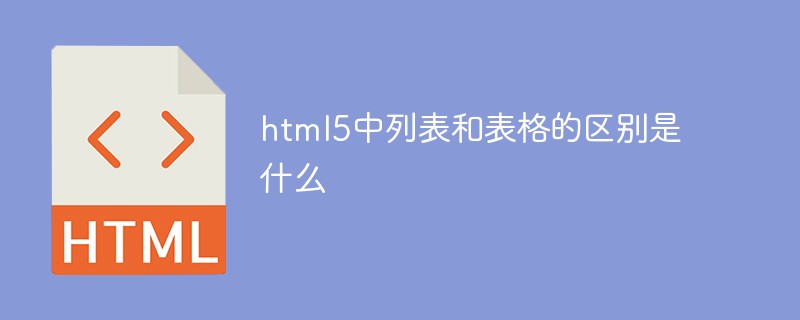 html5中列表和表格的区别是什么Apr 28, 2022 pm 01:58 PM
html5中列表和表格的区别是什么Apr 28, 2022 pm 01:58 PMhtml5中列表和表格的区别:1、表格主要是用于显示数据的,而列表主要是用于给数据进行布局;2、表格是使用table标签配合tr、td、th等标签进行定义的,列表是利用li标签配合ol、ul等标签进行定义的。
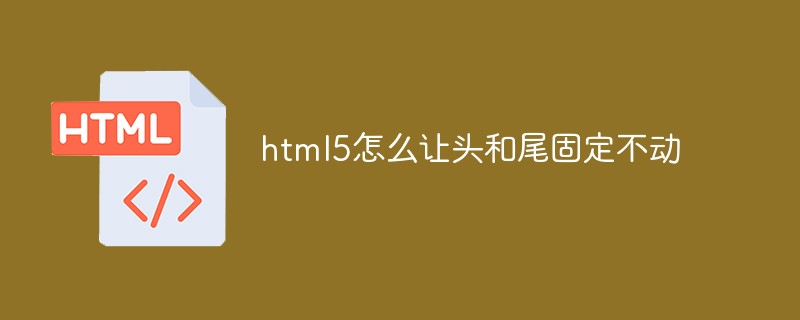 html5怎么让头和尾固定不动Apr 25, 2022 pm 02:30 PM
html5怎么让头和尾固定不动Apr 25, 2022 pm 02:30 PM固定方法:1、使用header标签定义文档头部内容,并添加“position:fixed;top:0;”样式让其固定不动;2、使用footer标签定义尾部内容,并添加“position: fixed;bottom: 0;”样式让其固定不动。
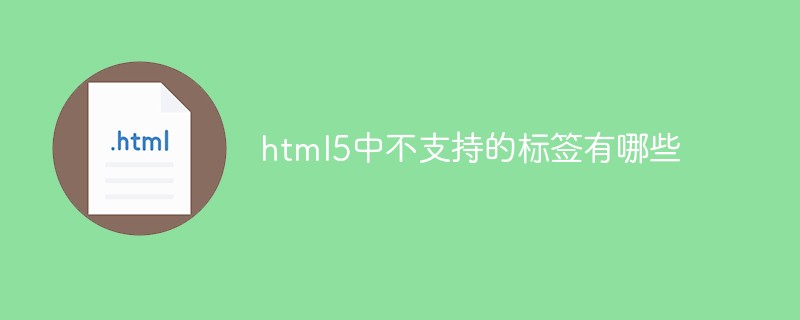 html5中不支持的标签有哪些Mar 17, 2022 pm 05:43 PM
html5中不支持的标签有哪些Mar 17, 2022 pm 05:43 PMhtml5中不支持的标签有:1、acronym,用于定义首字母缩写,可用abbr替代;2、basefont,可利用css样式替代;3、applet,可用object替代;4、dir,定义目录列表,可用ul替代;5、big,定义大号文本等等。
 HTML5中画布标签是什么May 18, 2022 pm 04:55 PM
HTML5中画布标签是什么May 18, 2022 pm 04:55 PMHTML5中画布标签是“<canvas>”。canvas标签用于图形的绘制,它只是一个矩形的图形容器,绘制图形必须通过脚本(通常是JavaScript)来完成;开发者可利用多种js方法来在canvas中绘制路径、盒、圆、字符以及添加图像等。
 html5废弃了哪个列表标签Jun 01, 2022 pm 06:32 PM
html5废弃了哪个列表标签Jun 01, 2022 pm 06:32 PMhtml5废弃了dir列表标签。dir标签被用来定义目录列表,一般和li标签配合使用,在dir标签对中通过li标签来设置列表项,语法“<dir><li>列表项值</li>...</dir>”。HTML5已经不支持dir,可使用ul标签取代。
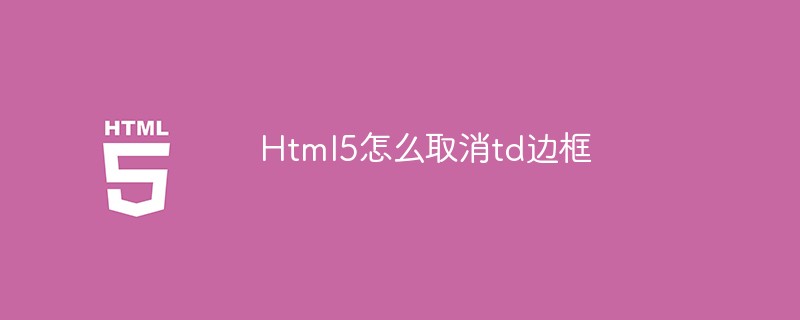 Html5怎么取消td边框May 18, 2022 pm 06:57 PM
Html5怎么取消td边框May 18, 2022 pm 06:57 PM3种取消方法:1、给td元素添加“border:none”无边框样式即可,语法“td{border:none}”。2、给td元素添加“border:0”样式,语法“td{border:0;}”,将td边框的宽度设置为0即可。3、给td元素添加“border:transparent”样式,语法“td{border:transparent;}”,将td边框的颜色设置为透明即可。
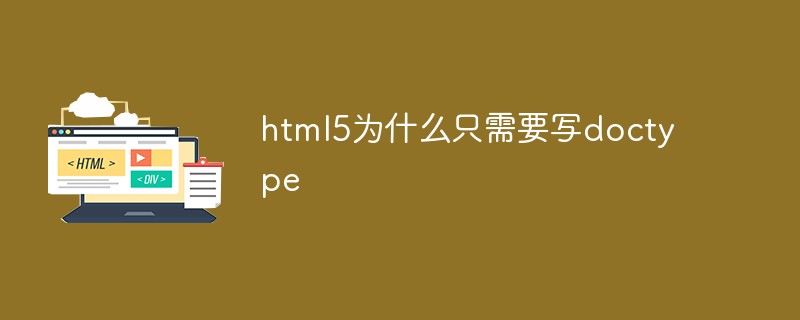 html5为什么只需要写doctypeJun 07, 2022 pm 05:15 PM
html5为什么只需要写doctypeJun 07, 2022 pm 05:15 PM因为html5不基于SGML(标准通用置标语言),不需要对DTD进行引用,但是需要doctype来规范浏览器的行为,也即按照正常的方式来运行,因此html5只需要写doctype即可。“!DOCTYPE”是一种标准通用标记语言的文档类型声明,用于告诉浏览器编写页面所用的标记的版本。


Hot AI Tools

Undresser.AI Undress
AI-powered app for creating realistic nude photos

AI Clothes Remover
Online AI tool for removing clothes from photos.

Undress AI Tool
Undress images for free

Clothoff.io
AI clothes remover

AI Hentai Generator
Generate AI Hentai for free.

Hot Article

Hot Tools

Atom editor mac version download
The most popular open source editor

Notepad++7.3.1
Easy-to-use and free code editor

SAP NetWeaver Server Adapter for Eclipse
Integrate Eclipse with SAP NetWeaver application server.

VSCode Windows 64-bit Download
A free and powerful IDE editor launched by Microsoft

Safe Exam Browser
Safe Exam Browser is a secure browser environment for taking online exams securely. This software turns any computer into a secure workstation. It controls access to any utility and prevents students from using unauthorized resources.




